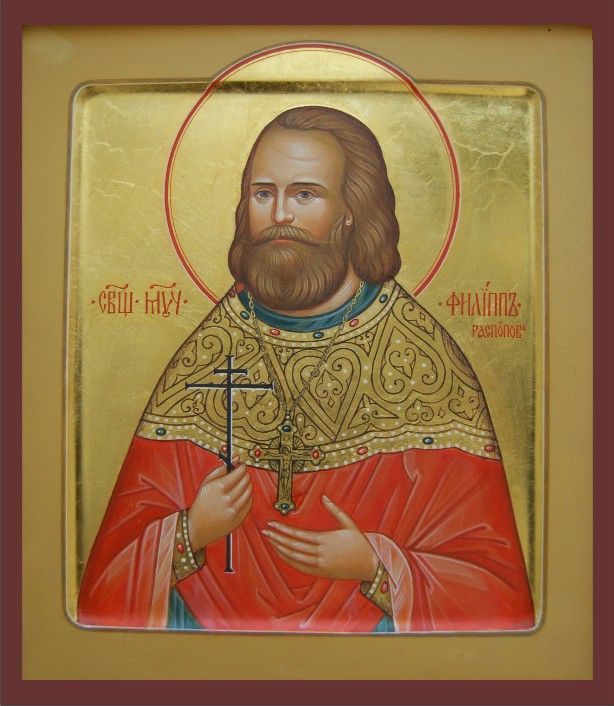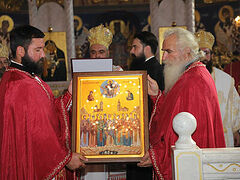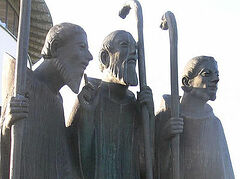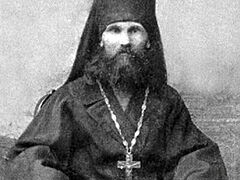St. Petersburg, August 25, 2023
 Hieromartyr Philip Raspopov was among those canonized yesterday. Photo: http://pravkhabarovsk.ru/
Hieromartyr Philip Raspopov was among those canonized yesterday. Photo: http://pravkhabarovsk.ru/
The Holy Synod of the Russian Orthodox Church gathered in St. Petersburg yesterday under the chairmanship of His Holiness Patriarch Kirill of Moscow and All Russia.
The hierarchs made several decisions regarding saints and feast days, including the canonization of several new saints.
In particular, the Synod resolved to add three names to the Synaxis of New Martyrs and Confessors of the Russian Church, each to be commemorated on the day of his martyrdom: Priest Leonid Serebrennikov (December 25/January 7), Priest Philip Raspopov (November 23/December 6), and Priest Vasily Nosov (September 21/October 4).
If found, their remains should be honored as holy relics, and icons are to be painted in their honor, the Synod states.
St. Philip is also to be included in the Synaxis of Saints of Samara, and St. Vasily in the Synaxis of the Saints of Chelyabinsk.
The Synod also established the feast of All Saints Who Have Shone Forth in the Land of Germany, to be celebrated on the Sunday closest to September 20/October 3.
German dioceses began formally collecting material on the lives of their local saints in 2018, and in 2022, the information was submitted to the Synodal Commission for the Canonization of Saints, which studied the materials and passed them on to the Synod.
At present, the Russian Synod has blessed the inclusion of 12 saints, with more still being considered:
- Hieromartyr Boniface, Archbishop of Mainz, Enlightener of Germany (754);
- Hieromartyr Aureus, Bishop of Mainz (436);
- The Martyr Mauritius and those with him: Gereon, Cassius, Florentius and other soldiers (c. 300);
- Martyr Aphra of Augsburg (304);
- St. Maximinus, Bishop of Trier (347);
- St. Maternus, the first Bishop of Cologne (4th century);
- St. Korbinian, the first Bishop of Freising (725/730);
- St. Willibrord, Archbishop of Utrecht (739);
- St. Burkard, Bishop of Würzburg (753);
- St. Ansgar, Archbishop of Hamburg (865);
- St. Lioba of Bischofsheim (728);
- Venerable Walpurga of Eichstetten (779)
The Synod also formally recognized the remains found at the Meeting of the Lord Church in Staropyshminsk, Sverdlovsk Province (near Ekaterinburg) in 2022 as those of Hieromartyr Deacon John Plotnikov, who was martyred by the Bolsheviks in 1918, and blessed them to be venerated as such.
The Russian Synod also formally entered a number of recently glorified Serbian saints into the Russian liturgical calendar, including Hiero-Confessor St. Irinej (Ćirić) of Bačka (March 24/April 6), the Holy Martyrs of Žitomislići Monastery in Bosnia who were brutally tortured by the Ustaše on June 26, 1941 (June 13/26), and the hundreds of Holy Child Martyrs of the Jastrebarsko and Sisak concentration camps in Croatia (July 13/26).
***
St. Leonid Konstantinovich Serebrennikov, the son of a priest in the Vilna Province, was born on April 14, 1894. In 1904-1910 he studied at the Vilna Theological School. In 1912-1915 he served as a reader in the Vilna Province. In May 1915 he married, then was a student of pastoral courses in Moscow. In the same year he was ordained a deacon, and in March 1916 a priest. The ordinations were performed by Bishop Innokenty (Solodchin) at the Holy Protection Monastery in Moscow. Upon completion of the pastoral courses in May 1916, Fr. Leonid Serebrennikov was appointed to the Novo-Pokrovsky resettlement parish of the village of Lermontovskoye, Primorsky Region (now the village of Lermontovskoye, Khabarovsk Territory), and in January 1917 he was transferred to the Holy Protection Church of the same village.
In early January 1919, a partisan detachment led by Yefim Garmashov entered the village of Lermontovka. In addition to robbery and sabotage against the interventionists, the detachment carried out reprisals against people who, in their opinion, interfered with the cause of the revolution. Priests were among them. In one of these reprisals on Christmas Day, December 25/January 7, 1919, Fr. Leonid Serebrennikov was killed.
The following story about the martyrdom of a priest was passed down from generation to generation: “In 1919, on Christmas Day, after a Christmas tree organized in the parish school, Fr. Leonid was captured by a band of Bolsheviks and taken to the river in a severe frost, where he was undressed and put on ice. Father was very strong and kind. The bandits mocked the priest, who, being of great stature and remarkable strength, did not resist his killers. They jumped on him, rolled on his back to the river, poked with knives, then forced him to chisel an ice-hole, stripped him and with the words: “You baptized us, and we will baptize you”—lowered him under water. When he, already wounded, clung to the edge of the ice, they crushed all his fingers on his hands, then he went under water, and in the morning people fished out his body and buried it. This story is confirmed by the old-timers of the village.
On the initiative of the parishioners of the current church in honor of the Archangel Michael in the village of Lermontovka, a memorial service is performed on the day of the death of Fr. Leonid, who is revered by local people as the patron of the village of Lermontovka.
***
St. Philip Kuzmich Raspopov was born in the village of Matveevka, Buguruslan district, Samara Province, on October 3, 1875, a peasant son. After graduating from the parish school, Philip Raspopov remained a novice at the St. Nicholas Monastery in the city of Samara, but, realizing his lack of inclination towards the monastic path, he turned to the bishop with a request to direct him to parochial obedience, after which he was sent to the parish in the village of Tupikovka, Buzuluk district, as a psalmist and Church school teachers.
In 1900-1903, Philip Raspopov served in the military in China. In December 1903, he was admitted to the Blagoveshchensk Diocese and appointed reader and singer of the Duya marching church, participating in the celebration of Divine services in the Khabarovsk Cathedral and directing the choir. In the summer of 1904, he was moved to the Burukan missionary camp with the obligation to direct the cathedral choir of singers and help in the construction of a catechism school.
In 1904, Philip Raspopov got married, after which he became clergy. On June 11, 1906, he was ordained a deacon, after which he served in Khabarovsk, and on January 8, 1912, he was ordained a priest at the church in the village of Vyatskoe. In November 1914, Fr. Philip Raspopov was transferred to the Holy Trinity parish in the village of Dole-Troitskoye, with the care of the former parish retained.
Throughout his life, Fr. Philip accompanied his pastoral ministry with educational activities, which he began as a teacher at a parochial school back in the Samara period of his life. In Nikolaevsk-on-Amur, he acted as a teacher of the law at the Pyankovskoye Folk School. While serving in the village of Vyatskoye, he taught the Law of God to local children and preached the Gospel to the indigenous peoples of the Amur region. In 1914 he was appointed teacher of the Trinity School.
During the First World War, Fr. Philip participated in the collection of donations in favor of Russian prisoners of war, for which archpastoral gratitude was expressed to him.
On November 23 / December 6, 1919, partisans broke into the Raspopovs’ house. In severe frost, they dragged Father Philip out into the street almost without clothes and dragged him to the Amur River. There, on the river ice, they mocked him for a long time: They insulted and beat him, and then lowered Fr. Philip into a hole under the ice, where he accepted a martyr’s death. According to eyewitnesses, the priest behaved with dignity and did not renounce his faith.
In the Amur village of Troitskoye, the veneration of Fr. Philip began immediately after the revival of liturgical life here in the mid-1990s. Regular prayer services are performed in the Holy Trinity parish of the village of Troitskoye, where Fr. Philip served and was martyred. The memory of Fr. Philip was also restored in his homeland. In the village of Matveevka, Samara Region, where Fr. Philip was born, they know and remember the priest. The days of his death and birth are prayerfully honored in the local church.
***
St. Vasily Mikhailovich Nosov was born on January 29, 1886 in the village of Yekaterinovskaya in the Kuban in the family of the Kuban Cossack Mikhail Nosov and his wife Agafia. He graduated from the parochial school and passed the exam for the title of teacher of the public school. In 1908, his family moved to the Kustanai District of the Turgai Region. In 1913, Vasily Nosov entered the pastoral missionary school at the Orenburg Bishop’s House, where missionary priests were trained.
Upon graduation, Vasily Nosov married and in 1915 was ordained a deacon, then a priest. Fr. Vasily served in various churches in the Kustanai District and taught the Law of God in a rural school, and in 1919 he was transferred to the city of Miass.
In 1922, a Renovationist split broke out. Fr. Vasily did not accept Renovationism and was sent to forced labor to fell wood five miles from the city of Miass. Believers continued to secretly come to Fr. Vasily. Communicating with them, he forbade going to the services of the Renovationists and asked them to make every effort to free the church from them. The representative of the Higher Church Administration came to Fr. Vasily and proposed that he accept Renovationism in exchange for a return to service in the Sts. Peter and Paul Church, but received a categorical refusal.
In early 1923, Fr. Vasily was released and returned to Miass, where he continued his ministry in the Sts. Peter and Paul Church. The parishioners fell in love with Fr. Basil for his devotion to the faith of Christ, kindness and piety, for the impeccable performance of pastoral duties.
On February 6, 1930, Fr. Vasily was again arrested and imprisoned in the Zlatoust prison on charges of anti-Soviet activities and statements against collective farm construction. During interrogation, he pleaded not guilty. In April, Fr. Vasily was sentenced to 8 years in a concentration camp. He served his sentence in the Vishera camp and on the construction of the White Sea-Baltic Canal.
Five years later, Fr. Vasily was released ahead of schedule. Returning to Miass, he wanted to continue serving in the church, but the authorities did not provide him with registration, and he was forced to take a job as a carpenter.
Believers began to come to Fr. Vasily for pastoral care at home, and sometimes invited him to celebrate services in their homes. Relatives advised him to leave Miass, fearing that he would be arrested again. To these persuasions, the priest replied: “The Lord did not hide from His enemies, and I will not do this, and I will not give my spiritual children to the wolves, but there, as God wills, His holy will is for everything.”
In February 1937, the priest was again arrested and imprisoned in the Chelyabinsk prison, and in September of the same year he was sentenced to death. During interrogations, he denied his guilt, did not slander anyone and did not name names. On October 4, 1937, Fr. Vasily Nosov was shot and buried in a common grave.
Follow OrthoChristian on Twitter, Vkontakte, Telegram, WhatsApp, MeWe, and Gab!



